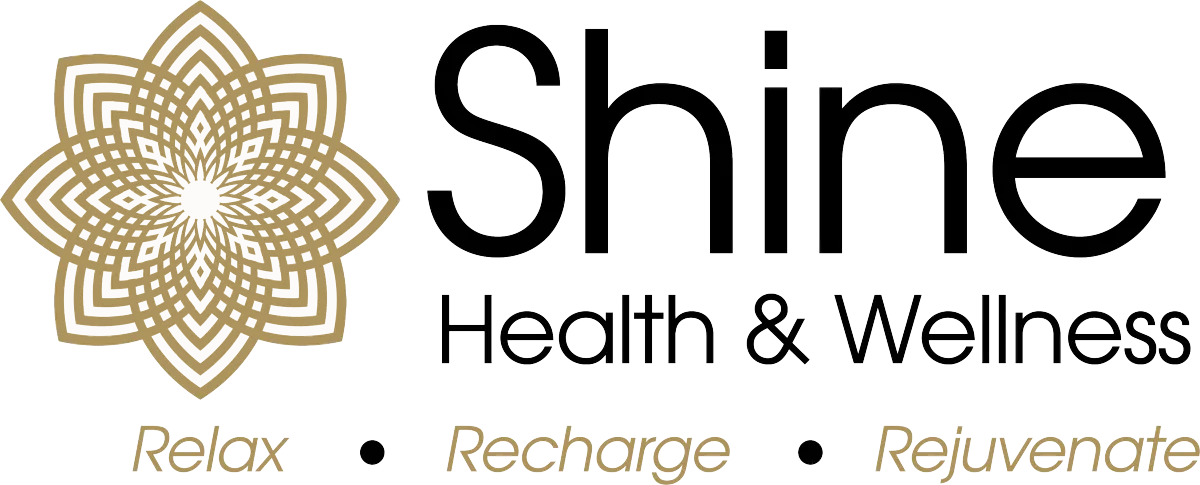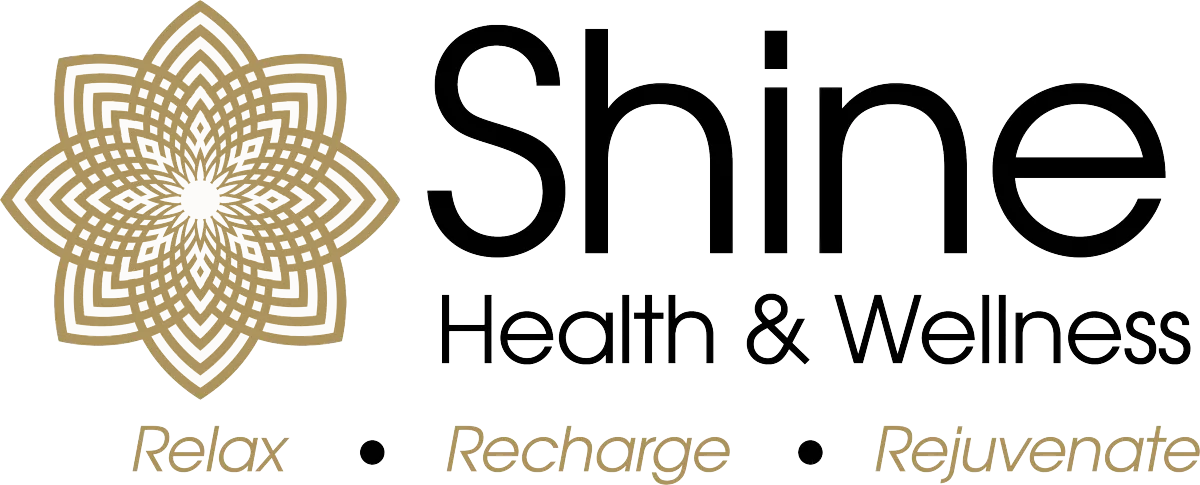
Harness the power of bioactive red light wavelengths to boost cellular energy,
enhance skin health, and accelerate recovery.
What is Red Light Therapy ?
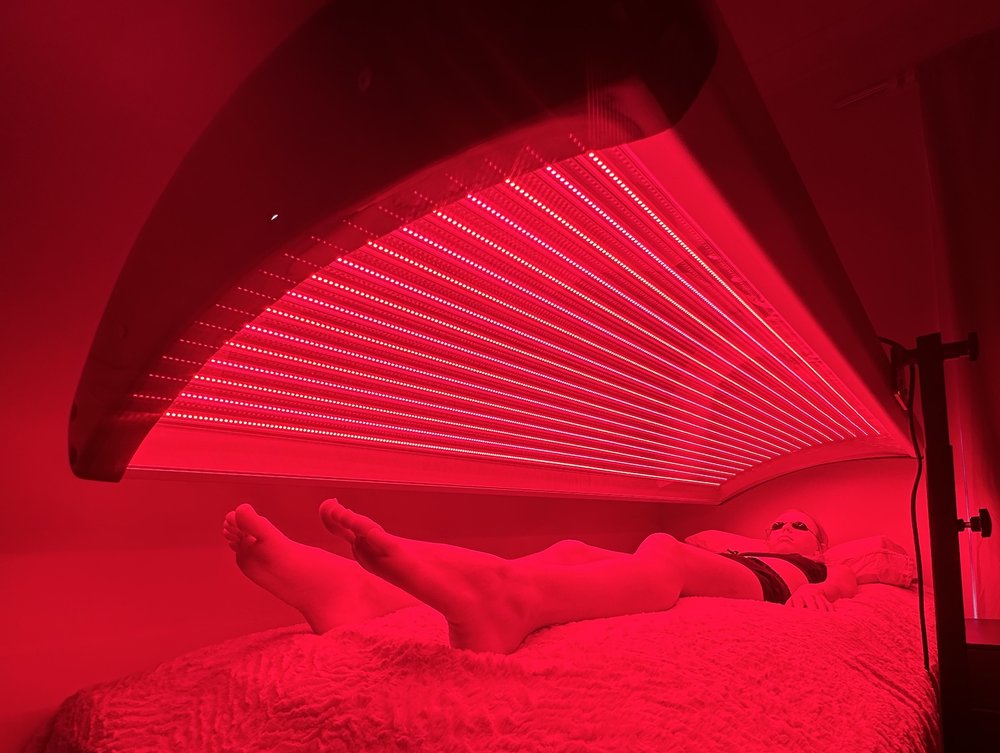
Please Book Your Appointment Below
What are the Key Benefits of Red Light Therapy ?
Through years of research, Red Light Therapy has been found to be profoundly therapeutic with dozens of aesthetic and health benefits:
Wrinkle reduction
Skin tone evening
Flushing and redness reduction
Weight loss
Weight management
Pain management
Stretch mark reversal
Hair regrowth
Muscle growth and recovery
Spider vein removal
Body detoxification
Skin and bone healing
Psoriasis treatment
Depression and anxiety reduction
Oral health
Eye health
Fertility
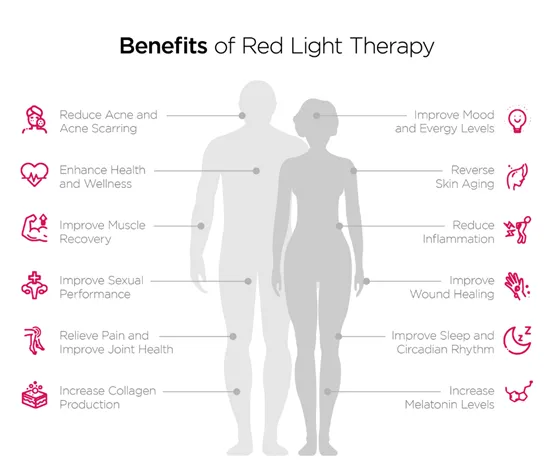
How Long Does Red Light Therapy Take to Work?
Red light therapy works quickly to treat acute conditions, such as an injury, and works over time to ease arthritis and other chronic conditions. Many patients see an improvement in their condition right after the first red light therapy session and continue to see improvements throughout the following weeks.
Red light therapy reduces acute and chronic inflammation
Red light therapy works immediately after the first treatment to reduce acute inflammation, and it eases chronic inflammation with every session. Acute inflammation is an immune response that helps the body avoid infection and promotes healing.
Red light therapy boosts the production of collagen immediately and over time
Collagen is a major building block of muscles, skin, bones, tendons and ligaments. This abundant protein helps wounds heal quickly and prevents the formation of scar tissue, including acne scars. Collagen adds elasticity to the skin, so it also helps prevent fine lines and wrinkles to prevent premature aging.
How long does it take for red light therapy to work on premature aging?
Red light therapy stimulates the production of collagen right away to promote skin health. Repeat treatments over the course of a few weeks helps reduce the visible signs of scars and aging.
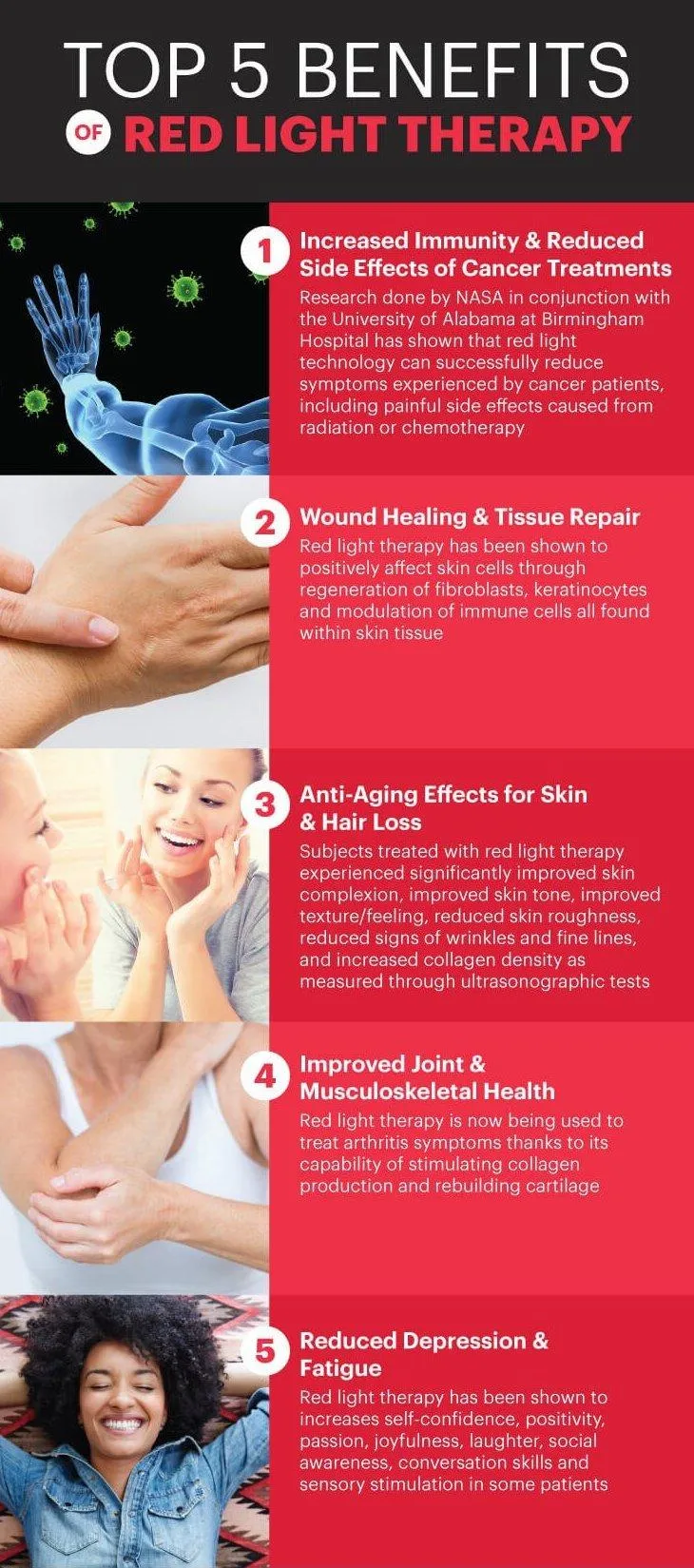
How Does Red Light Therapy Work?
Red light therapy is a low-level laser therapy that is a form of photobiomodulation.
Photobiomodulation refers to using light to modulate our biology.
This process exposes your body to low wavelength red lights that penetrate deep into your skin. Unlike ultraviolet (UV) rays from the sun, RLT is safe and doesn’t burn your skin. You won’t get a tan or get a sunburn, instead, you receive all the benefits of the red light deep inside on a cellular level when standing or sitting several inches from an RLT device. This process may help to increase cellular energy and antioxidants in your body.
Research has shown that through red light therapy, the mitochondria in the skin cells are able to soak up the beneficial light particles, create more ATP energy, and able to fuel all cells with energy with it. Since your body is able to use this extra energy for rejuvenation and repair, this energy provided to your cells may contribute to many of the positive benefits of RLT.

Reduces Inflammation and Pain
Red light therapy is also incredibly beneficial for pain and inflammation. According to a systemic review and meta-analysis evaluating low-level laser therapy for musculoskeletal disorders in adults, RLT may reduce pain when used regularly and a recommended dose.
Another study has discussed the benefits of this therapy on inflammation. It seems that it improves inflammatory and inflammation-related chronic health issues, including psoriasis, tendonitis, obesity, arthritis, and autoimmune thyroiditis.
Red light therapy may be particularly beneficial if you have arthritis or other joint-related inflammation or pain. A meta-analysis looked at the benefits of red-light therapy.
Scientists looked at 13 trials. 212 patients received randomized laser, 174 patients got the placebo laser, and 68 patients recieved active laser on one of their hands and placebo on their other hand. Treatment lasted from 4 to 10 weeks with follow-ups to 3 months.
Researchers have found that RLT was effective for rheumatoid arthritis and osteoarthritis with few side effects. Another randomized double-blind study has found that RLT may benefit knee osteoarthritis and compliance with rehabilitation exercises.
Improves Skin Conditions
One of the main reasons people use red light therapy is for its skin health benefits. A study on the benefits of the stimulating, repair, and skin benefits of RLT found that it may increase collagen production, fibroblast production, mRNA and circulation between skin cells. As a result, RLT may help skin elasticity and facial texture, reduce fine lines and wrinkles, and lower free radical damage.
In a study involving 136 people, red light therapy visibly reduced fine lines, wrinkles, skin roughness, and increased collagen density. Researchers determined red light therapy provides safe treatment of skin tissue with high patient satisfaction rates.
Red light therapy may also help to treat acne. When applied to the skin, red light therapy reduces inflammation and increases turnover of keratinocytes, the most common type of skin cell that makes up the structure of our top layer of skin. There have also been promising studies on the treatment of mild-to-moderate acne with a combination of red light and blue light. Just like sunlight it may reduce sebum production. However, too much sun exposure can be problematic because of the ultraviolet (UV) and UVB rays, making RLT a great option. Another study has found that it may improve complexion and the overall feeling of the skin, and help to rejuvenate skin cells.
Stimulates Mitochondrial Health
The mitochondria are the powerhouse of your cells. They are small organelles that are the center of cellular energy in your body.
Researchers have found that one of the main benefits of red-light therapy is that it helps to stimulate mitochondrial health and help your mitochondria to create more energy. This happens because the red and near-infrared lights interconnect with certain photoreceptors called cytochrome c oxidase within your cells. This process allows the mitochondria to use oxygen more efficiently which results in the production of more ATP.
ATP is the molecular unit of currency for the intracellular energy transfer process. It is a complex organic chemical that supplies your living cells with energy to help bodily processes, including chemical synthesis, nerve function, and muscle contraction. Healthier more energy efficient mitochondria help to improve energy and mental clarity.
Please Book Your Appointment Below
Improves Circadian Rhythm & Sleep Quality
Red light therapy may be a natural and effective sleep aid that improves your circadian rhythm and sleep quality. Exposure to red light may help your body to adjust its circadian rhythm resulting in physical, mental, and behavioral changes and benefits.
A study on female basketball players has found that using red light therapy for 14 days for 30 minutes each day resulted in better sleep quality and improved endurance performance based on melatonin release and the Pittsburgh Sleep Quality Index (PSQI) questionnaire.
Another study on different color temperatures has found that red light therapy may be beneficial for
sleep. They looked at exposure to different color temperatures before research participants spent sleeping in darkness. Melatonin production and body temperature during sleep was different for each light and has shown improvements for RLT.
Supports Hair Growth
If you are looking to grow beautiful hair or simply want to grow more or better quality hair, red light therapy may be an option. About 50 percent of man over 40 and 75 percent of women over 65 suffer from Androgenetic Alopecia, a common form of hair loss. Research has found that light therapy may benefit this population.
A study on 90 participants between ages 18 and 70 found that low-level red light therapy may help people with alopecia, or spot balding. Participants who received red light therapy of 665 nanometers (nm) and 808 nm improved their hair density compared to the control group. A further meta-analysis of 8 clinical studies of 11 double-blind randomized trials has found that red light therapy may result in a significant increase in hair growth and hair density.
A meta-analysis of 11 studies involving 667 people found red light therapy improved hair density and thickness with minimal side effects. Applying treatment for under one hour per week was most effective. Most of the examined studies used red light at wavelengths of 630-660 nanometers (nm), however some studies used dual-wavelength devices.
Promotes Wound Healing & Tissue Repair
One of the most commonly known benefits of red-light therapy is wound healing. It has been well-researched and has been used in professional settings in order to improve wound healing and tissue repair. According to a review of 68 studies on the biological effects of red light therapy on wound healing, it may help to reduce inflammation in the skin cells, increase collagen and fibroblast production, and help angiogenesis, or new blood vessel growth stimulation. The review concluded that red light therapy is beneficial for wound healing and tissue repair, however, treatment protocol, wavelength, and the dose may be important and determine the outcome.
Reduces Muscle Pain and Inflammation
In a review of studies on red light therapy and its effect on muscle tissue, researchers found red light may be able to activate, heal, and regenerate damaged muscle tissue. The studies have shown red light can help enhance sports performance in athletes when it’s delivered to muscles either before exercise or after exercise.
The review also showed red light therapy may help increase the level of muscle mass gained after training, as well as decrease inflammation and oxidative stress in muscle biopsies.
Red light therapy works by increasing blood flow and stimulating cell regeneration. Essentially, these devices help the mitochondria in muscular cells complete their respiration cycle more efficiently, which makes the muscles suffer less fatigue. Improving the mitochondrial respiration cycle leads to better activation and formation of the muscle stem cells that eventually develop into healthy muscle tissue. This means that athletes who use red light therapy on their muscles can experience long-lasting healthy muscle tissue as a result.
Red light therapy also reduces inflammation that damages cells and makes muscles sore. Light therapy has also been shown to help grow muscles, making it not only a workout recovery asset, but also a boost to make your workouts more effective.
Clinical Evidence for Red Light Therapy for Arthritis and Pain Relief
Red light therapy has a strong clinical track record for osteoarthritis pain. In one double-blind clinical study, 50 patients with degenerative osteoarthritis in both knees were treated with either red light, infrared light, or a placebo for ten days. The red and infrared groups saw their pain reduced by over 50%. This led the research team to conclude that red light therapy “is effective in relieving pain and disability in degenerative osteoarthritis of the knee.”
Red light therapy has also been shown to be effective for ankle pain. In a 2018 clinical trial, patients with acute ankle sprains were treated with red light from LED devices for six days. Compared to a placebo group, the patients reported significantly less ankle pain after three days.
Red light therapy has consistently shown good clinical results for lower back pain. Infrared and near infrared light have demonstrated improved pain scores in studies and trials, especially for the treatment of chronic lower back pain.
How Does Red Light Therapy Treat Fat Cells?
We know that red light therapy offers a wide variety of different health benefits, from reducing inflammation and the effects of oxidative stress to boosting the body’s natural healing ability. But what does red light therapy do to fat cells to promote fat reduction?
In addition to boosting your cells with increased ATP production, red light therapy also affects adipocytes, or the cells that store fat. Studies, such as the 2011 study published in
Obesity
Surgery, show that exposure to red light therapy causes the adipocytes to release triglycerides, resulting in reduced volume and a measurable loss of fat. Participants in this 4-week study experienced a 2.15 cm loss in waist girth. Most research points to modest fat loss after six or more treatments of red light therapy. But the loss of triglycerides is not the only benefit red light therapy provides to patients trying to lose weight and improve body contour.

Studies Show Additional Weight Loss Benefits with Red Light Therapy
Not only can red light therapy help reduce the size of fat cells, thus helping to shape the body contour, but it also provides additional benefits for patients working to lose weight.
A 2012 study published in the International Journal of Endocrinology looked at the effects of light on leptin and ghrelin. Leptin is a hormone responsible for controlling appetite, helping to maintain body weight, and regulating how much energy the body burns. In contrast, ghrelin increases appetite and stimulates the release of growth hormone. In this study, researches looked at participants with poor sleep habits. Reduced sleep levels often increase the production on ghrelin while reducing the levels of leptin, often resulting in weight gain. Their research showed that exposure to red light significantly increased leptin levels while decreasing ghrelin. This reduction in hunger levels can have a great impact on those trying to follow a low-calorie diet for weight loss, helping to reduce hunger and the desire for snacking.
Another study looked at how red light therapy can provide additional benefits during regular exercise routines. The study, published in Lasers in Surgery and Medicine, looked at the effects of light therapy on metabolic inflexibility when used with physical training. During the study, 64 obese women were divided into two groups. The control group participated in exercise training while receiving a placebo light treatment. The second group participated in exercise training and received red light therapy immediately after exercise. Both groups participated in three weekly sessions for 20 weeks. At the end of the study, researchers observed a greater reduction in fat mass and an increase in total skeletal muscles mass and adiponectin concentration compared to the control group.
While clinical research has shown how valuable red light therapy is for a variety of medical conditions, it is also highly beneficial for patients looking to lose weight, reduce fat, and imbody contour. Red light therapy is a safe, non-invasive treatment option that provides effective results, helping patients achieve their weight loss goals.
How light therapy works to treat depression
When we don’t get adequate natural light, it affects every cell and process within our body. Humans were made to use sunlight for optimal health. Healthy light is essential to every cell’s function, and a lack of light can lead to chronic disease and illness.
Lack of sunlight has been known to cause anxiety and depression because not enough sunshine depletes brain serotonin and dopamine levels, and those low levels can lead to disabling mood conditions. Staying indoors for extended periods affects mental well-being. In addition to clinical depression and anxiety, low levels of Serotonin are also associated with depressive disorders like seasonal affective disorder (SAD), a type of mood disorder influenced by the changing daylight hours.
Red light therapy can specifically:
Increase sluggish energy levels
Support a balanced mood
Improve mental clarity and confidence
Improve general positivity, calm, and reduce anxiety
Reduce seasonal depression (SAD)Light therapy compensates for the lack of exposure to sunlight that may contribute to major depressive disorder with seasonal patterns.
The research Trusted Source on light therapy gives a few reasons why it may improve the symptoms of depression. Reasons include that it:
works on your biological clock by aligning your brain’s 24-hour cycle (aka circadian rhythm)
balances the activation of serotonin circuitry in your brain, which is a key component in mood regulation
contributes to stable and consistent sleep patterns
increases alertness
May Treat Traumatic Brain Injury and Other Brain Disorders
Red light therapy has been studied as a treatment for traumatic brain injury and other brain disorders. One study found participants with chronic, mild traumatic brain injury (mTBI) reported improved sleep and fewer post-traumatic stress disorder (PTSD) symptoms after scalp application of red and near-infrared light.
The participants also reported improved ability to perform social, interpersonal, and occupational functions. Another study showed red light therapy applied to the head can improve symptoms from traumatic events (stroke, traumatic brain injury, and global ischemia), degenerative diseases (dementia, Alzheimer's, and Parkinson's), and psychiatric disorders (depression, anxiety, and post-traumatic stress disorder). There is also a possibility this type of therapy can improve cognitive function in individuals not suffering from any of these conditions or diseases.
Reducing the Side Effects of Cancer Treatment
In France, Red Light Therapy is being tested to accelerate the healing and regeneration of tissues damaged by heavy cancer treatments such as chemotherapy and radiotherapy. Near-infrared photoimmunotherapy uses an antibody–photo absorber conjugate that binds to cancer cells. When near-infrared light is applied, the cells swell and then burst, causing the cancer cell to die. Photoimmunotherapy is in clinical trials in patients with inoperable tumors.
Please Book Your Appointment Below
Red Light Therapy Killing Cancer Cells
Near-infrared photoimmunotherapy uses an antibody–photoabsorber conjugate that binds to cancer cells. When near-infrared light is applied, the cells swell and then burst, causing the cancer cell to die. Photoimmunotherapy is in clinical trials in patients with inoperable tumors.
That said, studies from the past 20 years suggest that RLT may help reduce some cancer treatment side effects, such as oral mucositis, radiation dermatitis, and lymphedema.
Red light therapy is already widely medically accepted in its use in photodynamic therapy. In this therapy, low-power red laser light is used to activate a photosensitizer drug. The interaction creates a chemical reaction that destroys cells. It’s used to treat some skin conditions, including skin cancer and psoriasis, acne and warts, and other types of cancer.

TESTIMONIALS
What others are saying
"Loved everything so far"
“I can say without a doubt the contribution to my wellbeing during an intense health challenge has been nothing short of remarkable. I was experiencing excruciating pain and was extremely debilitated when I showed up to Natasha. Within one session the change was extraordinary. I left with no pain and my eyes instead of sunken in and dark were now bright again."
- Michelle
"My life changed forever"
"For the last year I have struggled with excruciating sciatica pain having to sleep in a chair every night to try find some comfort. Natasha and her team have transformed my life in just 2 months - I am pain free and happily sleeping in my bed again. I can’t thank you enough!"
- July
"Highly recommend this"
"My 9 year old boy was really struggling at school from being bullied as a shy introvert and being neuro diverse struggling with learning. We had to pull him out to school and home school him, as he did not want to socialise with anyone. Natasha’s deep relaxation therapy helped him release his anxiety and bottled up emotions in such a gentle way. The brightness has returned to his eyes, he is happy again and expressing his personality that was suppressed for so long. His confidence has increased massively and he has asked to go back to school! Thank you so much for giving me my boy back."
- Tash
Please Book Your Appointment Below
